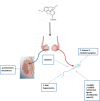Codeine-induced sperm DNA damage is mediated predominantly by oxidative stress rather than apoptosis
- PMID: 32290793
- PMCID: PMC7189206
- DOI: 10.1080/13510002.2020.1752003
Codeine-induced sperm DNA damage is mediated predominantly by oxidative stress rather than apoptosis
Abstract
ABSTRACTBackground: Opioids have been implicated to induce infertility. Although codeine remains the most used opioid for recreational purpose, no study has documented its effect on sperm quality. Elucidating the effect of codeine on sperm cells and the associated mechanisms may provide an insight into preventing drug-induced sperm damage. Twenty-one New Zealand white rabbits were randomized into three groups; control and codeine-treated. The codeine-treated groups received either 4 or 10mg/kg b.w of codeine for six weeks.Results: Codeine treatment led to significant decrease in sperm count, motility, viability, normal morphology, and sperm membrane integrity. This was associated with significant rise in sperm DNA fragmentation, oxidative damage, and caspase 3 activity. The percentage of sperm DNA fragmentation correlates positively with 8-hydroxy-2'-deoxyguanosine, a biomarker of oxidative DNA damage, and caspase 3 activity, a biomarker of apoptosis. The observed correlation was stronger between sperm DNA fragmentation and oxidative DNA damage than sperm DNA fragmentation and caspase 3 activity.Conclusion: This study revealed that chronic codeine exposure causes sperm DNA fragmentation and poor sperm quality primarily via oxidative stress rather than activation of caspase 3-dependent apoptosis. Findings of the present study may explain drug-induced male factor infertility, particularly, those associated with opioid use.
Keywords: 8OHdG; Codeine; caspase; fertility; infertility; opioids; oxidative stress; sperm DNA fragmentation; testosterone.
Conflict of interest statement
No potential conflict of interest was reported by the author(s).
Figures




References
-
- Yeşilli C, Mungan G, Seçkiner I, et al. . Effect of varicocelectomy on sperm creatine kinase, HspA2 chaperone protein (creatine kinase-M type), LDH, LDH-X, and lipid peroxidation product levels in infertile men with varicocele. Urology. 2005;66:610–615. doi: 10.1016/j.urology.2005.03.078 - DOI - PubMed
-
- World Health Organization . Laboratory manual for the examination of human semen and sperm-cervical mucus interaction. 4th ed. New York: Cambridge University Press; 1999.
-
- Moghissi KS, Wallach EE.. Unexplained infertility. Fertil Steril. 1983;39:5–21. - PubMed
MeSH terms
Substances
LinkOut - more resources
Full Text Sources
Medical
Research Materials
